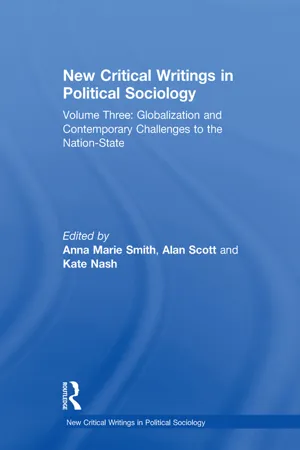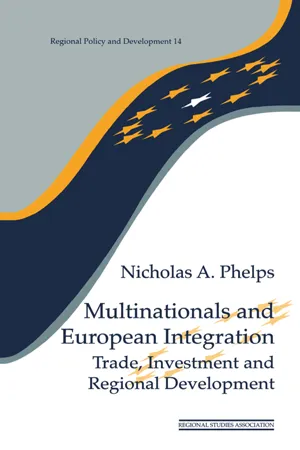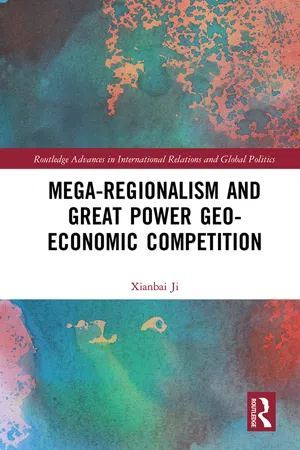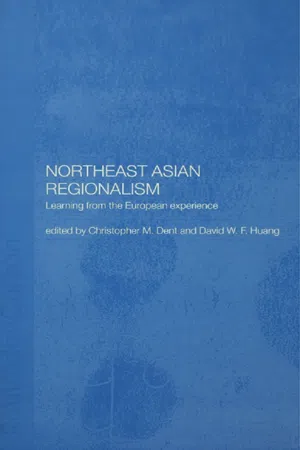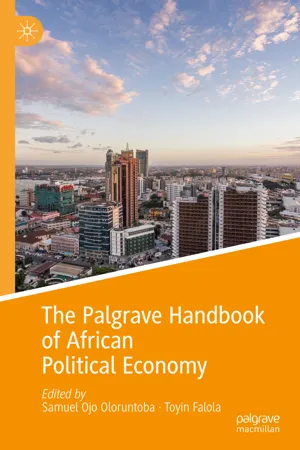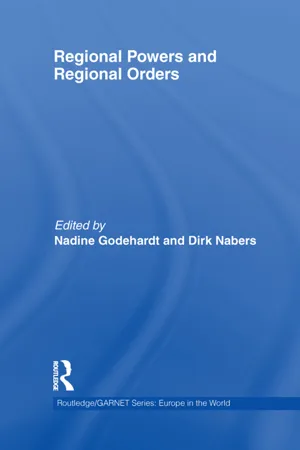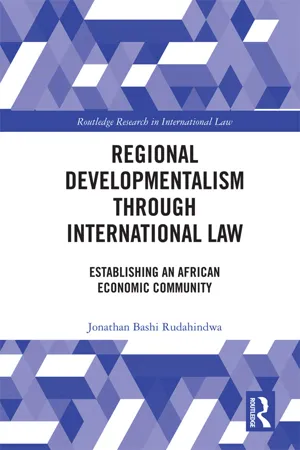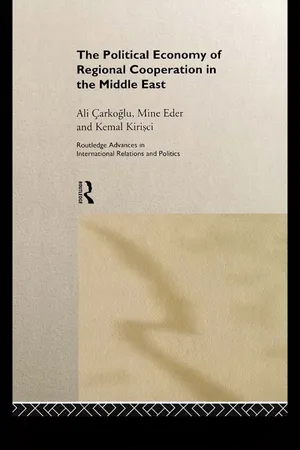Politics & International Relations
Economic Regionalism
Economic regionalism refers to the process of countries within a specific geographic region coming together to form agreements and institutions aimed at promoting economic cooperation and integration. This can involve the creation of free trade areas, customs unions, or common markets to facilitate the flow of goods, services, and investments within the region. The goal is to enhance economic growth and development among member countries.
Written by Perlego with AI-assistance
Related key terms
Related key terms
1 of 4
Related key terms
1 of 3
12 Key excerpts on "Economic Regionalism"
- eBook - ePub
New Critical Writings in Political Sociology
Volume Three: Globalization and Contemporary Challenges to the Nation-State
- Alan Scott, Anna Marie Smith(Authors)
- 2017(Publication Date)
- Routledge(Publisher)
Because regions and their boundaries change when states leave or join them and when power relations within and between them are significantly redefined, the new regionalism argues that regional change occurs when critical political and territorial saliencies are reframed by the participating states. In political regionalism, key issues concern the stability of the region, the security of its members, its contribution to the current global order, and the relationship of the member states to the global system (see also Hurrell and Fawcett 1995). In effect, regionalization is a dynamic and flexible process in which change is continual rather than happening by distinct leaps and bounds; the emergence of a shared identity is necessarily an evolutionary process.Economic Regions
Economic regionalization appears to depend on both political decisions at the regional level and the locational decisions made by firms. In effect, regions are viewed as an appropriate unit in which to organize governance and stimulate political participation. But often, as in the European Union, regional governance has remained weak. In fact, its regional dimension has been more manifest in the rise of economic pivot regions and of capital- and technology-intensive cities that support local development. There is evidence to suggest that, at least in Europe, differences in regional growth rates have depended on a combination of local conditions and their linkages to the world economy (Le Gales and Lequesne 1998; Rodriguez-Pose 1998; Braunerhjelm et al. 2000; Newman 2000). Neither the state nor regional government alone can assure regional success that is based on the interrelationship among local resources, transnational capital, and public-private interactions. Loose policy initiatives and regional networks cannot save a regional project if its market incentives are inadequate (Cowling and Sugden 1999; Koch and Fuchs 2000).Regional specialization and growth are due both to expanding trade and investment as well as endogenous factors. Decreasing transaction costs play a role in the relocation of production within and between countries. The result is a center-periphery division that changes as development spurts integrate new regions into the center. Due to backward and forward linkages, production tends to agglomerate to areas where there is already similar production, irrespective of the intensity of trade relations (Fujita, Krugman, and Venables 1999; Venables 1999). - eBook - ePub
Multinationals and European Integration
Trade, Investment and Regional Development
- Nicholas A. Phelps(Author)
- 2013(Publication Date)
- Routledge(Publisher)
CHAPTER 2 The Political Economy of European Integration Regionalism At once the EU stands as the most potent symbol of, and the major force behind, the contemporary regionalisation of trade. The EU’s sphere of influence in world trade has steadily grown to effectively undermine the purpose of the General Agreement on Tariffs and Trade (GATT) and multilateralism. Through both a widening (from the original 6 to the current 15) and deepening, the EU has become the major trade bloc in the world economy; one which has become powerful enough to frustrate the GATT under the leadership of the US. Furthermore, the EU’s influence on world trade does not end there, it extends through its trade relations with much of the rest of the world. Regional economic integration can be considered both as a state of affairs and as a process (Balassa, 1962, cited in Chisholm, 1995). Integration as a state of affairs can be conceived in terms of several stages of integration. There are four main stages of economic integration which are usually identified – the free trade area, the customs union, the common market and the economic union – though to this list we can add an initial and more general category of the regional trade bloc. The term trade bloc is general enough to encapsulate any of the four formalised states of economic integration but also allows one to consider groupings of countries which are not integrated by way of formalised arrangements but rather by de facto trade and investment patterns. Four general conditions make for a coherent trade bloc; similar levels of per capita GNP, geographic proximity, similar or compatible trading regimes, and political commitment to regional organisation (Schott, 1991: 2). As a first stage of regional economic integration we may have a collection of countries for which there are no common formal arrangements as in a free trade area but which satisfy the conditions above - Xianbai Ji(Author)
- 2021(Publication Date)
- Routledge(Publisher)
Geopolitical considerations that have historically animated the emergence of regionalism are in close connection with the broader relationship between trade liberalisation and political integration. Depending on the sequencing of the two oft-interrelated undertakings, FTA plays different roles. FTA and the associated economic process can activate regional integration in a political sense. 8 According to this neo-functionalist view, the spill-over effects of trade integration create an enabling socio-economic and policy environment that makes the need for deeper integration on political and institutional matters appealing and inescapable (WTO 2011). The most discussed case in this regard is the EU (Lindberg 1963). The establishment of the Pacific Alliance (PA) in 2011 linking together Chile, Colombia, Mexico and Peru (Villarreal 2016, Herreros 2016) is yet another example. The objective of the PA goes beyond building an enlarged local market to projecting the members’ joint strengths to the Pacific Asia. The four PA countries move expeditiously along a sliding scale from economics to politics, towards the goal of deep integration. They have agreed to eliminate nearly all tariffs by 2020, coordinate trade and investment promotion activities overseas, scrap intra-PA tourist visa requirements for each other’s citizens, create the Latin American Integrated Market and pool diplomatic resources by opening up joint embassies in countries like Vietnam (Nolte 2016). Conversely, regionalism can be contemplated to complement or renew a pre-existing “high-politics” process wherein the importance of “low-politics” issues like trade liberalisation had previously been downplayed for one reason or another- eBook - ePub
Regionalism in Hard Times
Competitive and post-liberal trends in Europe, Asia, Africa, and the Americas
- Mario Telò(Author)
- 2016(Publication Date)
- Routledge(Publisher)
The number, scope, and influence of these associations and regimes has increased considerably since the early 1980s, in parallel with globalization. 2 (d) A customs union with a common trade policy : these include common external tariff and foreign economic policy (for example, MERCOSUR), the EU, and the Southern African Customs Union (SACU), including five members of (SADC). The definition of ‘strategic regionalism’, that is competing for defending regional geoeconomic interests and asserting distinctive socio-economic and learning models, could also be used to cope with such a phenomenon. (e) We understand economic regional integration to be a common market and an economic union, including not only cooperation, but also coordination of national macroeconomic policies and sometimes currencies, through various intergovernmental and, rarely, supranational institutions. (f) The new regionalist approach emphasizes that regions are not only entities of social interaction, but also of policymaking and polity construction. We don’t understand a ‘regional polity’ to be a regional federal State, but various forms/regimes of political cooperation (up to gradually coordinating national policies in sensitive fields) and an institutional capacity to minimize internal asymmetries and maximize external influence. 3 Furthermore, what matters as the sociopolitical construction or ‘cognitive regionalism’ are communitarian feelings of shared identity. Finally, there is not an evolutionary sequence: all the five types of cooperation above do not need to be included within this deeper step. Using the historical and theoretical framework provided by the chapter one, we will focus on empirical and comparative questions - Ernesto Vivares(Author)
- 2016(Publication Date)
- Routledge(Publisher)
Three elements can be identified as the central weaknesses of neoliberal institutionalism. The first is the idea that regionalism is defined by its level of institutionalization subordinated to the dynamic of trade and based on the major regional experiences (EU, NAFTA, APEC). Secondly, there exits the identification of regionalism as a state-led project of integration which confines the concept of regionalism and its research to state and governmental agency, leaving out not only strategic areas of analysis but also conflict and well-being. Finally, there is the reduction of regionalism to a trade phenomenon where institutions only play a role in creating incentives and constraints to given processes (Söderbaum, 2005).The third most influential and dominant school of thinking on regionalism in South America is the body of economic theories called regional economic integration or liberal regional economic integration. This set of economic integration approaches generally cement the relation between—and are the basis of—the economic assumptions upon which neorealism and neoliberal institutionalism are founded. According to these approaches, regional integration proceeds through a sequence of trade and economic agreements that define a model of linear evolution in order to reach complete economic integration. According to the Balassa model (1961), the progression from preferential trade areas to free trade areas, with customs unions, common markets, monetary unions, and ending up with a complete economic area, generally is the basis of most of the research on regionalism in regional development banks (Estevadeordal and Suominen, 2007). These theories are concerned principally with the welfare effects as the result of trade creation, diversion, and integration (Cable and Henderson, 1994), although they present rigid limitations to integrally explain development given their disciplinary boundaries.Liberal regional economic integration approaches are usually used in combination with actor-oriented theories, with the aim of generating models to predict and enhance paths of interstate cooperation (Estevadeordal and Suominen, 2007: 4). In this sense, there are two different lines of economic integration research. The first line of study concentrates on whether the impact of Economic Regionalism contributes to the world trading system. The second group, also created to explain economic integration in Europe, distances itself from orthodox economics by focusing more on investment, employment, infrastructure, and structural transformations, as well as market and government failures (Robson, 1993).- eBook - ePub
Northeast Asian Regionalism
Lessons from the European Experience
- Christopher M. Dent, David W. F. Huang(Authors)
- 2002(Publication Date)
- Routledge(Publisher)
5 Third, the chapter discusses regional co-operation in the Asia-Pacific region from the perspective of economic regionalization and evaluates of the differences between Europe and Asia-Pacific in terms of theoretical basis and developmental experience. Finally Northeast Asia subregionalism is discussed and the problems and prospects for promoting more integration in this area is evaluated.2. Regionalism and Regional Integration in the Global Political Economy (i) Theoretical DiscoursesSince the late 1980s a resurgence of regionalism has emerged in the world economy and politics. Some regard it as a positive and permanent characteristic of the post-Cold War international order. Others are more skeptical and believe that regionalism, which flourished in the 1960s, will have a limited application and shelf life.6 Most theoretical analysis of contemporary regionalism focuses on the impact of regional interdependence and highlights the importance of domestic factors. There are various reasons given to explain the rise of regionalism in relation to developments in the international political economy, for example, the end of the Cold War and the erosion of the Cold War alliance system; the impact of increasing economic integration and globalization; changed attitudes towards economic development in most parts of the developing world and the impact of democracy and democratization. Most academic discussion of regionalism focuses on analysing a particular regionalist arrangement, be it the EU, NAFTA, or ASEAN and continuing discussions within the Asia-Pacific region over new economic and security agreements like APEC, Pacific Economic Co-operation Council (PECC), and ASEAN Regional Forum (ARF). These discussions emphasize the trends of regional trading blocs on the one hand and co-operation and integration on the subregional level on the other hand.7 - Samuel Ojo Oloruntoba, Toyin Falola, Samuel Ojo Oloruntoba, Toyin Falola, Samuel Ojo Oloruntoba, Toyin Falola(Authors)
- 2020(Publication Date)
- Palgrave Macmillan(Publisher)
Part VII Regional Integration and Africa Political EconomyPassage contains an image
© The Author(s) 2020Begin AbstractS. O. Oloruntoba, T. Falola (eds.)The Palgrave Handbook of African Political Economy Palgrave Handbooks in IPE https://doi.org/10.1007/978-3-030-38922-2_5252. The Languages and Grammar of Regionalism
End AbstractDaniel C. Bach1(1) Department of International Relations, Sciences Po Bordeaux, Centre Emile Durkheim, Pessac, FranceThe renaissance of regionalism in the 1990s has drawn attention to issues and processes that were previously ignored or deemed of marginal significance. This chapter discusses how this trend has ushered deep changes in the conceptualization of the dynamics at play across the African continent and the Global South in general. Theories of regional integration were until then primarily concerned with the experience of the European Union (EU ). The decisive shift came with the acknowledgment of the global economic and geostrategic imprint of the Asia-Pacific region, a trend that has kept consolidating since then, along with the rise of China and India as key players within the global economy. Equally important, perhaps, fresh attention paid to the “world of regions” (Katzenstein 2005- eBook - ePub
A Brief History of the Future
The United States In A Changing World Order
- Allan E. Goodman(Author)
- 2019(Publication Date)
- Routledge(Publisher)
1 Regions tend to grow—and increase demands for goods and services—far faster than individual countries. The resources and capital people exchange within the region tend to be used very efficiently: More sellers can find more buyers, and individual nations are free to specialize in the production of profitable goods and services and to purchase what they do not have and what things they need from regional producers. In the past, many nations were forced to diversify production or to tap natural resources in order to ensure economic independence and national security. As the process evolvesand more goods and services are exchanged, more income is created to allow people to improve their lives and develop tastes for additional goods and services produced outside the region. As this occurs, theregion attracts extra-regional investment, and this creates jobs and even more income.The bottom line is that through regional integration—or at least through the creation of common market arrangements—the majority of the people will benefit and trade will increase as more buyers begin to search for more sellers and, due to population growth, there are more and more customers, even for those commodities now in surplus. Regionalization also promotes democratization and political stability. It tends to create an atmosphere and an impetus for countries to respect basic human rights across all types of systems; it also allows goods, capital, and people to move freely and puts subtle economic and social pressure on individual countries to reduce illegal or unscheduled political actions and changes that jeopardize the continued attraction of extra-regional resources and direct investment. Never in history has a regional market succeeded by closing itself off to the rest of the world.Present Obstacles
Of course, numerous past attempts at regional integration have not been successful. However, the mostencouraginglessonderived from these failures is that virtually every study points to the lack of political will on the part of those who had the chance to participate in these attempts and not to the impracticability of such arrangements for enhancing economic growth and trade. No one has really demonstrated that integration makes poor economic sense, only that many leaders thus far have lacked the vision and courage to surmount the initial obstacles to itscreation. Consequently, I think it isat least possible to foresee a period in which the appeal of political incentives for integration will grow at both the mass and elite levels and that this will overcome the resistance that has derailed past efforts. - eBook - ePub
- Nadine Godehardt, Dirk Nabers(Authors)
- 2011(Publication Date)
- Routledge(Publisher)
Subacchi 2008 ).- What contribution can the economics of regional powers make to regional powers theory?
My contribution will consider the discourse on the economics of regional powers and, starting from here, will conceptually investigate the above questions in order to enhance and ultimately empirically test the concept of regional powers. In this contribution, I do not refer to the concepts of the BRICs nations (Brazil, Russia, India, China), ‘rising powers’ or ‘emerging powers’ (Wilson and Purushothaman 2003 ; Nolte 2006 ). All those studies which do so already address the shifting of economic and political power relations.In Section 3, I provide an overview of the economic discourses on the role of regional powers’ influence on countries in the region. In Section 4, I develop a proposal for a concept of the economics of regional powers. This discussion is based on the review and evaluation of data. Section 4 presents the results.Economic discourse on the role of regional powers' influence on countries in the region
As early as the nineteenth and early twentieth centuries there were economic works on the dominance of developed nation- states, which shaped the development of less developed states, such as Friedrich List’s theory on British supremacy in Europe and in the world (List 1959 ). Leadership in the economic process of modern capitalism has also been analysed by Alois Schumpeter. He focuses on technological revolutions and their diffusion. Entrepreneurs bring together a bundle of incremental and fundamental innovations, implement new combinations and trigger a ‘creative destruction’ that generates growth. Innovation encompasses the following: (1) the creation of a new good or new quality of good, (2) the creation of a new method of production, (3) the opening of a new market, (4) the capture of a new source of supply and (5) a new organization of industry (for example, the creation or destruction of a monopoly). Countries with the will to win dominate over those without an innovative dynamic. As a result of the disruptions, transitions from ‘the respective centre of gravity to another’ occur (Schumpeter 1987: 99 ). Due to this outcompeting of the old powers, new combinations of production factors, which require financing with loans, prevail; authority or credit, according to Schumpeter’s assessment, are the means, together with the will to win and the joy of creating, through which ‘leadership’ comes into being (Schumpeter 1987: 127 and 138 - eBook - ePub
Regional Developmentalism through Law
Establishing an African Economic Community
- Jonathan Bashi Rudahindwa(Author)
- 2018(Publication Date)
- Routledge(Publisher)
3In the particular context of Africa, regional integration has often been associated with economic growth and development, as the former is believed to support the achievement of the latter.4 As discussed in a previous chapter, comparative advantage and economies of scale have often been used as rationale for regional integration in Africa, as it is believed that the African economies, being too small to be viable and to benefit from global economy, would benefit from the integration of their different national markets, economies of scale as well as the pooling of their means of production.5 Regional integration has therefore been included in the development discourse and listed as one of the key points in the development policies articulated at the continental level.In order to clearly identify the key factors that have influenced the development discourse in Africa and their correlation with regional integration, the chapter is divided into four key periods which have been affected by different approaches to and/or theories of development and have subsequently produced various sets of different development policies: the period of self-reliance and state-led developmentalism (1960s to early 1980s), which followed the independence of a majority of African countries and influenced the adoption of the Charter of the OAU and the Lagos Plan of Action (LPA); the period of structural adjustment, the Washington Consensus and the subsequent focus on trade liberalisation (1980s to 1990s), which witnessed the significant reduction in the role of the state and the adoption of the Treaty of Abuja; the Post-Washington Consensus (1990s to 2000s) with the adoption of the New Partnership for Africa’s Development (NEPAD) Framework; and recent developments, including the Continental Free Trade Area (CFTA), the Tripartite Free Trade Area (TFTA), the Action Plan for Boosting Intra-African Trade (BIAT) and the Programme for Infrastructure Development in Africa (PIDA). - Ali Carkoglu, Mine Eder, Kemal Kirisci(Authors)
- 2005(Publication Date)
- Routledge(Publisher)
3 Political economy of regional cooperation Towards a modelThis study is based on the argument that there is a complex set of domestic political factors that affect the extent and nature of cooperation in the Middle East which will in turn affect the respective domestic constituencies in each country of the region. The composition and articulation of interests by different groups in the countries of the Middle East are not only affected by the developments in the international environment but are also moulded by changes in their economies and political structures. Any move by decision-makers of the Middle Eastern countries to change the existing set of economic and political relationships towards more or less cooperative milieux will have to be approved by the relevant domestic constituencies and other political forces. The interaction between the domestic and international actors must be understood in order to explain the character and prospects of political and economic cooperation in the region.We specifically focus on the following set of questions: Under what conditions is regional economic and political cooperation meaningful and possible? What determines the prospects and constraints of regional cooperation? Who are the main actors involved? What level of analysis should be used to locate the main actors? How do they influence the policy outcomes? These questions constitute the core issues for social scientists from a wide variety of fields including international relations, political economy and trade theory. This study aims to respond to these questions through analysing the prospects of economic and political cooperation in the Middle East. While we explore international, regional and domestic political and economic factors that shape the dynamics of regional cooperation in the Middle East, we also try to address several theoretical issues on regionalism. These issues include:- eBook - ePub
China Deconstructs
Politics, Trade and Regionalism
- David S.G. Goodman, Gerald Segal(Authors)
- 2002(Publication Date)
- Routledge(Publisher)
The overall results of the changes of economic outlook in the PRC and within East Asia include not only increased border trade, but also the PRC’s integration into the economic order of East Asia. However, the pattern of economic integration has not been even. Though each of the East Asian economies has traded with and invested in the various areas of the PRC, there has been a high degree of specialisation. Different parts of the PRC have established particular economic links with specific—sometimes industry- as well as country- or territory- based—parts of East Asia. Most spectacularly, the economy of Guangdong Province is dominated by its relationship with Hong Kong; that of Fujian Province by its relationship with Taiwan, on which it is almost totally dependent for its industrial development. Domestic developments have thus encouraged Economic Regionalism within the PRC at the same time as international developments have encouraged China’s regionalisation within East Asia.It is possible that under these various regional pressures China may follow the path of political disintegration mapped out in Eastern Europe and the former USSR. However, any assessment of the prospects for political disintegration must examine the structures that maintain or may even increase integration as well as those that encourage disintegration. They must also take care not to confuse the epiphenomena of the political process—in which the regional dimension has been and remains important—with manifestations of more deep-rooted significance.Regional economic growth certainly has the potential to lead to political disintegration, but it is not a necessary consequence. Nor is that consequence necessarily signalled by developments in the late 1980s and early 1990s. Such arguments are based on three assumptions that are almost self-evidently too simple: an almost exclusive economic determinism; a simple, conflictual model of relations between centre and province; and the equation of China’s new economic regions with the traditional provinces, and the kinds of regionalism that have existed before in China’s history.China’s history certainly provides many examples of regionalism. These have at times led to political particularism and separatism, as for example most recently during the Warlord Era of 1917–1927. However, it does not automatically follow that all regionalist tendencies in China are directed towards, or indeed will arrive at, political independence. The centralised state in the nineteenth and twentieth centuries may have stressed a unity based on conformity throughout China, but that is not the only tradition.
Index pages curate the most relevant extracts from our library of academic textbooks. They’ve been created using an in-house natural language model (NLM), each adding context and meaning to key research topics.
Explore more topic indexes
Explore more topic indexes
1 of 6
Explore more topic indexes
1 of 4
